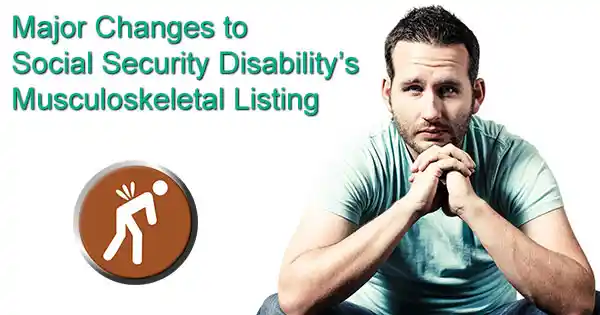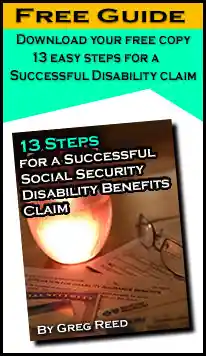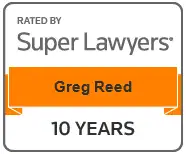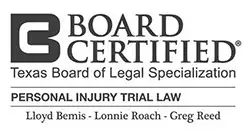Major Changes to Social Security’s Back Problem Impairment Listings
What are the changes made to the SSA’s listing for back problems and how do they affect me?
Author Attorney Greg Reed:
The Social Security Administration has made definitive changes to its musculoskeletal listing in its Blue Book which are sure to impact applicants seeking Social Security Disability benefits for back problems.

The SSA has made changes to its musculoskeletal listing which are sure to impact applicants seeking Disability benefits for back problems.
The Blue Book lists impairments that are considered so severe that an individual is prevented from performing any type of work and describes the criteria Social Security uses to evaluate claims for disability.
These listings automatically qualify an applicant for disability benefits, provided the applicant meets the listing criteria as well as Social Security’s financial requirements. The musculoskeletal listing covers back and spine issues, joint issues, broken bones and amputations. This new rule was proposed in December 2020 after a public comment period between May and July 2018. Social Security states that it is revising its criteria to reflect its “adjudicative experience, advances in medical knowledge, and comments we received from the public in response to a notice of proposed rulemaking (NPRM)” and to provide guidance to disability adjudicators when evaluating evidence in cases involving musculoskeletal disorders.
The main changes include:
- The listings have been renumbered and now have multiple requirements
- A separate listing for spinal stenosis (See Listing 1.16)
- A new listing for pathological fractures, fractures that are the result of a disease process instead of trauma, was added. (See Listing 1.19)
- Spinal arachnoiditis has been removed from musculoskeletal listings and is now evaluated under neurological listing 11.08.
- Added wheeled and seated mobility devices to functional criteria based on how the device affects a person’s use of their upper extremities. An individual must be unable to use both hands for work-related tasks because of a disease such as arthritis, or the individual must be unable to use both hands because the individual needs to hold or use their hands on a device to walk or move, such as a wheelchair or crutches. This means that the inability to ambulate is no longer a basis of a disabling impairment. If an applicant uses a wheelchair or another mobility device that requires using only one hand, it is not a basis for a disabling impairment.
- Social Security also clarified that any assistive device – hand-held, wheeled, or worn – must be supported by medical documentation that details the need for the device over a 12-month period.
- An emphasis on documentation from an acceptable medical source, such as a doctor, surgeon, or nurse practitioner and medical imaging.
You can read the new listing here: https://www.ssa.gov/disability/professionals/bluebook/1.00-Musculoskeletal-Adult.htm.
Contact a Social Security disability attorney at 512-454-4000 for a free consultation and see if you can get disability benefits while suffering from back problems. If you have been denied disability don’t give up!
Social Security received 39 comments from legal organizations, advocacy groups, medical organizations, a state agency that makes disability determinations for Social Security, and individuals. Some commenters asked Social Security to withdraw the rule, arguing that:
- The changes were too stringent;
- Fewer applicants would qualify at the listing level; and
- Further assessment of cases would be necessary to make a determination that would prolong the process.
While the Social Security Administration declined to withdraw the rule, saying that listing impairments preclude the ability to perform “any gainful activity” and that the agency has the obligation to ensure the listings are up to date and reflect current medical criteria, it did consider public comments.
Social Security incorporated some suggestions by clarifying language and adding further explanation as to how they evaluate this impairment. A summary of the rule with public comments and Social Security’s responses can be found here: https://www.govinfo.gov/content/pkg/FR-2020-12-03/pdf/2020-25250.pdf
The new listing replaces the old and will apply to applications filed on or after April 2, 2021, as well as any claims pending on or after April 2.
This means if you had a hearing on a claim for back problems before April 2, and a judge has not made a decision yet, the new rules will apply to your case. If you are currently receiving Social Security Disability benefits because of a musculoskeletal disorder based on a previous listing, Social Security will not terminate your benefits. Social Security does not readjudicate cases that have been previously decided when listings are revised. Though Social Security must periodically conduct continuing disability reviews (CDR) to determine whether beneficiaries are still disabled, the new rules do not change the timeframe for conducting a CDR or how a CDR is conducted. To terminate benefits, Social Security must prove that the beneficiary’s medical condition has improved and that the improvement is “related to the “ability to work.” This means that even when a beneficiary’s medical condition has improved, if they are still unable to work, Social Security will find that the disability continues.

Some attorneys believe the changes will make it more difficult to meet the requirements of the musculoskeletal listing and will have the most impact at the initial and reconsideration stages of filing a claim.
Claimants should make sure that all symptoms are documented in their medical records. Applicants who rely on an assistive device must provide evidence from an accepted medical source that supports the need for the device and the circumstances for which the device is needed. Attorneys should update client medical documents to ensure doctors’ statements prove a client’s medical condition meets the requirements of the new listing.
Social Security receives more disability claims for back problems than any other condition and does not make it easy for an individual to qualify for benefits.
With the new changes in effect, now more than ever, it’s important to have the guidance and advice of a Social Security Disability attorney.
Disability benefits are an important source of income for those who are unable to work. If you are not able to work due to accident or illness, you may be eligible for Social Security Disability or Long Term Disability benefits. If you have applied for benefits and been denied, contact the attorneys at Bemis, Roach and Reed for a free consultation. Call 512-454-4000 and get help NOW.
Try these links for further reading on this subject:
Back Injuries and qualifying for Social Security Disability
Can Spinal Stenosis qualify for SS Disability Benefits?
Obtaining disability benefits for Spondylosis
Author: Attorney Greg Reed has been practicing law for 29 years. He is Superlawyers rated by Thomson Reuters and is Top AV Preeminent® and Client Champion Gold rated by Martindale Hubbell. Through his extensive litigation Mr. Reed obtained board certification from the Texas Board of Legal Specialization. Greg is admitted to practice in the United States District Court - all Texas Districts and the United States Court of Appeals-Fifth Circuit. Mr. Reed is a member of the Travis County Bar Association, Texas Trial Lawyers Association, past Director of the Capital Area Trial Lawyers Association, and an Associate member of the American Board of Trial Advocates. Mr. Reed and all the members of Bemis, Roach & Reed have been active participants in the Travis County Lawyer referral service.
Your Free Initial Consultation
Call now:
At Bemis, Roach and Reed, if we can't help you, we will try to find the right attorneys for you.
We offer each of our prospective clients a free no obligation one hour phone or office consultation to see if we can help you and if you are comfortable with us. We know how difficult a time like this can be and how hard the decisions are. If we can be of assistance to you and help you find a solution to your issue we will, even if that means referring you to another attorney.
Let's get you Started:
If you could provide us with some basic information about your claim we will get right back with you with a free case evaluation and schedule your Free Consultation Today.
You can also email us at: contact@brrlaw.com
Kind Words from Our Clients
“The attorneys and staff at Bemis, Roach & Reed have provided me and my husband, Jeff, with stellar advice, care, and service. They made navigating the SSDI process easy, painless, and as timely as possible. During this difficult time in our lives it was a tremendous relief to know they were on our side and keeping us updated on next steps and timelines. We also had questions about my husband’s long term disability insurance and they helped us get those questions answered and resolved without any additional fee. I highly recommend Bemis, Roach & Reed.” – Kelli G
“I needed a lawyer for my case and had googled best lawyers. They came up first on my list and decided to give them a call. From the moment I called I knew I chose the right people. They said they would fight for me and fight they did. They knew what they were doing and kept good communication throughout the process. If you need someone that will listen, understand, and fight then these are the people. HIGHLY RECOMMEND.” – Marcel L.
“I’ve had a great experience working with Bemis, Roach & Reed for my disability case. I spent two years fighting on my own, until I was informed to look for a disability lawyer. Right away, sending in questions was a breeze, and from the moment my case was accepted, everything became a major weight off my shoulders. My newest appeal was filed for me, my medical records and case history sorted for me, and I could finally focus on my appointments and treatment with a little less worry. Everything was explained to me in a way that made sense, the process was set out in an easy to understand way. And, just like that, at the beginning of July 2023, my claim was accepted!” – Sunshinemutt







